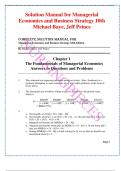Solution Manual for Managerial
Economics and Business Strategy 10th
Michael Baye, Jeff Prince
COMPLETE SOLUTION MANUAL FOR
Managerial Economics and Business Strategy 10th Edition
N
By Michael Baye, Jeff Prince
U
Chapter 1
RS
The Fundamentals of Managerial Economics
Answers to Questions and Problems
IN
1. This situation best represents producer-producer rivalry. Here, Southwest is a
G
producer attempting to steal customers away from other producers in the form of
lower prices.
PI
2. The maximum you would be willing to pay for this asset is the present value,
which is
EC
3.
ES
a. Net benefits are N(Q) = 20 + 24Q – 4Q2.
b. Net benefits when Q = 1 are N(1) = 20 + 24 – 4 = 40 and when Q = 5 they are
N(5) = 20 + 24(5) – 4(5)2 = 40.
c. Marginal net benefits are MNB(Q) = 24 – 8Q.
d. Marginal net benefits when Q 1 are MNB(1) = 24 – 8(1) = 16 and when Q 5
they are MNB(5) = 24 – 8(5) = -16.
e. Setting MNB(Q) = 24 – 8Q = 0 and solving for Q, we see that net benefits are
maximized when Q = 3.
Page 1
, f. When net benefits are maximized at Q = 3, marginal net benefits are zero. That is,
MNB(3) = 24 – 8(3) = 0.
4.
a. The value of the firm before it pays out current dividends is
.
b. The value of the firm immediately after paying the dividend is
N
Managerial Economics and Business Strategy, 10e
U
Copyright © 2022 by McGraw-Hill Education.
All rights reserved. No reproduction or distribution without the prior written consent of McGraw Hill Education.
RS
.
IN
5. The present value of the perpetual stream of cash flows. This is given by
G
6. The completed table looks like this:
PI
Control Total Net Marginal
Total Marginal Marginal
Net
Variable Benefits Cost Benefits Benefit Cost
EC
Benefit
Q B(Q) C(Q) N(Q) MB(Q) MC(Q)
MNB(Q)
100 1200 950 250 210 60 150
101 1400 1020 380 200 70 130
ES
102 1590 1100 490 190 80 110
103 1770 1190 580 180 90 90
104 1940 1290 650 170 100 70
105 2100 1400 700 160 110 50
106 2250 1520 730 150 120 30
107 2390 1650 740 140 130 10
108 2520 1790 730 130 140 -10
109 2640 1940 700 120 150 -30
110 2750 2100 650 110 160 -50
Page 2 Michael R. Baye & Jeffrey T. Prince
, a. Net benefits are maximized at Q = 107.
b. Marginal cost is slightly smaller than marginal benefit (MC = 130 and MB = 140).
This is due to the discrete nature of the control variable.
7.
a. The net present value of attending school is the present value of the benefits
derived from attending school (including the stream of higher earnings and the
value to you of the work environment and prestige that your education provides),
minus the opportunity cost of attending school. As noted in the text, the
opportunity cost of attending school is generally greater than the cost of books
and tuition. It is rational for an individual to enroll in graduate school when his or
her net present value is greater than zero.
N
b. Since this decreases the opportunity cost of getting an M.B.A., one would expect
more students to apply for admission into M.B.A. Programs.
U
8.
a. Her accounting profits are $170,000. These are computed as the difference
RS
between revenues ($200,000) and explicit costs ($30,000).
b. By working as a painter, Jaynet gives up the $110,000 she could have earned
under her next best alternative. This implicit cost of $110,000 is in addition to the
$30,000 in explicit costs. Since her economic costs are $140,000, her economic
profits are $200,000 - $140,000 = $60,000.
IN
9.
a. Total benefit when Q = 2 is B(2) = 20(2) – 2*22 = 32. When Q = 10, B(10) =
20(10) – 2*102 = 0.
G
b. Marginal benefit when Q = 2 is MB(2) = 20 – 4(2) = 12. When Q = 10, it is
MB(10) = 20 – 4(10) = -20.
c. The level of Q that maximizes total benefits satisfies MB(Q) = 20 – 4Q = 0, so Q
PI
= 5.
d. Total cost when Q = 2 is C(2) = 4 + 2*22 = 12. When Q = 10 C(Q) = 4 + 2*102 =
204.
EC
e. Marginal cost when Q = 2 is MC(Q) = 4(2) = 8. When Q = 10 MC(Q) = 4(10) =
40.
f. The level of Q that minimizes total cost is MC(Q) = 4Q = 0, or Q = 0.
g. Net benefits are maximized when MNB(Q) = MB(Q) - MC(Q) = 0, or 20 – 4Q –
ES
4Q = 0. Some algebra leads to Q = 20/8 = 2.5 as the level of output that
maximizes net benefits.
10.
a. The present value of the stream of accounting profits is
b. The present value of the stream of economic profits is
Managerial Economics and Business Strategy, 10e Page 3
, 11. First, recall the equation for the value of a firm: . Next, solve this
equation for g to obtain . Substituting in the known values implies a
growth rate of: percent. This would seem
N
to be a reasonable rate of growth: 0.0355 < 0.09 (g < i).
12. Effectively, this question boils down to the question of whether it is a good
U
investment to spend an extra $250 on a refrigerator that will save you $40 at the end
of each year for five years. The net present value of this investment is
RS
IN
.
G
You should buy the standard model, since doing so saves you $81.51 in present value
terms.
PI
13. Under a flat hourly wage, employees have little incentive to work hard as working
hard will not directly benefit them. This adversely affects the firm, since its profits
will be lower than the $25,000 per store that is obtainable each day when employees
EC
perform at their peak. Under the proposed pay structure, employees have a strong
incentive to increase effort, and this will benefit the firm. In particular, under the
fixed hourly wage, an employee receives $160 per day whether he or she works hard
or not. Under the new pay structure, an employee receives $330 per day if the store
achieves its maximum possible daily profit and only $80 if the store’s daily profit is
ES
zero. This provides employees an incentive to work hard and to exert peer pressure on
employees who might otherwise goof off. By providing employees an incentive to
earn extra money by working hard, both the firm and the employees will benefit.
14.
a. Accounting costs equal $145,000 per year in overhead and operating
expenses. Her implicit cost is the $75,000 salary that must be given up to
start the new business. Her opportunity cost includes both implicit and
explicit costs: $145,000 + $75,000 = $220,000.
Page 4 Michael R. Baye & Jeffrey T. Prince





